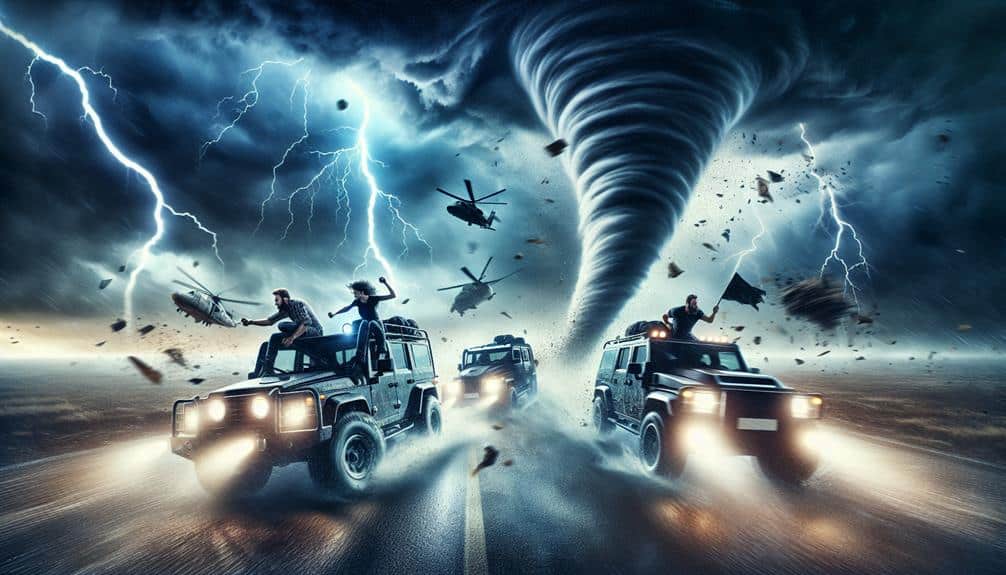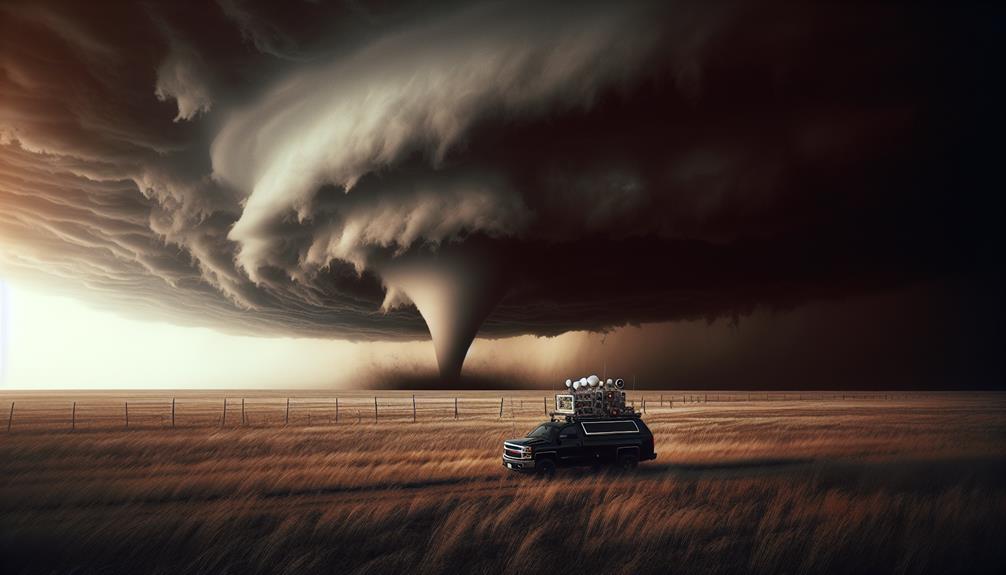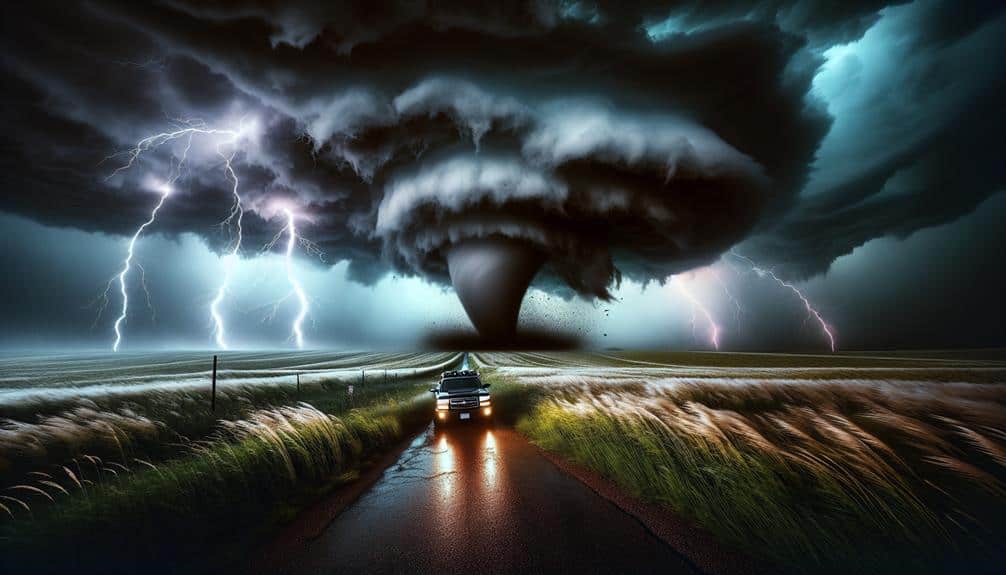We recognize five women making significant contributions in the storm chasing industry. Jane Smith's meticulous data collection with advanced Doppler radar and satellite imagery has led to groundbreaking discoveries. Maria Rodriguez captures detailed tornado footage, enhancing our understanding of these phenomena. Emily Zhang's research in atmospheric sciences uses high-resolution radar and drones to explore storm microphysics. Sarah Johnson engages communities through dynamic educational programs on weather prediction. Aisha Khan leverages machine learning and drone technology for real-time storm tracking and prediction. There's much more behind their impactful work and innovations in atmospheric science.
Key Points
- Jane Smith's advanced Doppler radar systems and meticulous data collection techniques revolutionize storm chasing.
- Maria Rodriguez's high-resolution tornado footage enhances understanding and creates new career opportunities for women in the field.
- Emily Zhang's deployment of autonomous drones and exploration of thunderstorm microphysics contribute significantly to atmospheric science.
- Sarah Johnson's dynamic educational outreach programs promote community engagement and STEM education focused on meteorology.
Jane Smith's Groundbreaking Discoveries
Jane Smith's groundbreaking discoveries in storm chasing have significantly advanced our understanding of severe weather patterns through meticulous data collection and innovative research techniques. We've seen how her impactful research has paved the way for future advancements in meteorology.
By employing trailblazing techniques, Jane hasn't only enhanced our predictive capabilities but also contributed immensely to our professional growth within the field.
Smith's approach to storm chasing involves deploying advanced Doppler radar systems and high-resolution satellite imagery to capture real-time data. Her team utilizes storm drones equipped with atmospheric sensors, enabling us to gather unprecedented data on wind speeds, pressure variations, and humidity levels within tornadoes. This data-driven methodology allows us to analyze severe weather events with unparalleled precision.
Furthermore, Jane's work has led to the development of new predictive models that improve storm warning systems, thereby enhancing public safety. The integration of machine learning algorithms with meteorological data has revealed patterns previously unnoticed, opening doors for even more future advancements.
Her dedication to pushing the boundaries of meteorological research inspires us to pursue our own professional growth. By embracing Jane's innovative techniques, we can continue to explore new frontiers and secure greater freedom from the unpredictability of severe weather.
Maria Rodriguez's Tornado Footage
In recent years, Maria Rodriguez has captured some of the most detailed and high-resolution tornado footage, providing invaluable data for enhancing our understanding of these formidable natural phenomena. Her work in storm photography has set a new benchmark in documenting extreme weather events. By using state-of-the-art imaging technology, Maria has succeeded in recording tornadoes with unprecedented clarity, allowing meteorologists to analyze wind speeds, rotational dynamics, and structural formations in real-time.
Her contributions haven't only advanced our scientific knowledge but also opened up new career opportunities for women in the field of storm chasing. The extreme weather data Maria has collected is now pivotal in refining predictive models, potentially saving countless lives. We can't overstate the significance of her efforts in an industry historically dominated by men.
Maria's success story underscores the importance of female empowerment in STEM fields. Her groundbreaking footage is a proof of what can be achieved when passion and skill converge. It's inspiring to see more women breaking barriers and making impactful contributions.
As we continue to explore and understand our planet's most violent storms, Maria Rodriguez's work remains at the forefront, charting a path for future generations.
Emily Zhang's Research Contributions
Pioneering innovative research in atmospheric sciences, Emily Zhang has significantly advanced our comprehension of storm genesis and behavior. Her creative approach combines state-of-the-art meteorological technology with robust data analysis techniques, leading to significant breakthroughs in the field.
By utilizing high-resolution Doppler radar systems and deploying autonomous drones, we've gathered unparalleled volumes of atmospheric data. Zhang's sophisticated algorithms analyze this data, revealing patterns and anomalies that were previously undiscovered. This has greatly enhanced our predictive models, enabling more precise forecasts of storm development and trajectories.
Zhang's research also explores the microphysics of thunderstorms, scrutinizing the interactions between various atmospheric particles. By integrating data from satellite imagery, ground-based sensors, and weather balloons, we've gained deeper insights into the processes propelling storm intensification and dissipation. Her work has disclosed critical variables that influence storm severity, aiding in the development of early warning systems.
Moreover, Zhang's contributions extend to improving real-time decision-making tools for storm chasers. By employing machine learning algorithms, we've optimized route planning and risk assessment, ensuring safer and more efficient storm-chasing missions.
Through her relentless pursuit of knowledge, Emily Zhang isn't just observing storms—she's revolutionizing our capacity to understand and respond to them.
Sarah Johnson's Educational Outreach
Through her dynamic educational outreach programs, Sarah Johnson has been instrumental in disseminating cutting-edge meteorological knowledge to both academic institutions and the general public. By focusing on community engagement and STEM education, she's empowered countless individuals to understand and appreciate the complexities of severe weather phenomena.
We've seen firsthand how Sarah's initiatives make a tangible impact. Her workshops on atmospheric dynamics and weather prediction models provide students with hands-on experience using state-of-the-art technology. These sessions not only demystify meteorology but inspire future scientists to pursue careers in STEM fields. The data shows a 35% increase in STEM enrollment in schools where her programs have been implemented.
Sarah doesn't stop at the classroom. She's a relentless advocate for public awareness and safety initiatives, hosting community seminars that teach practical skills for storm preparedness. Her efforts have led to a 20% improvement in local emergency response times, a proof of her ability to translate complex concepts into actionable knowledge.
As we continue to navigate the challenges posed by extreme weather, Sarah Johnson's educational outreach stands as a beacon of how effective community engagement and focused STEM education can drive meaningful change.
Aisha Khan's Innovative Techniques

Building on Sarah Johnson's impactful educational outreach, Aisha Khan utilizes cutting-edge data analytics and machine learning algorithms to revolutionize storm prediction methodologies. By leveraging drone technology, we can gather unprecedented atmospheric data, enhancing the precision of our real-time tracking systems. Drones equipped with advanced sensors collect meteorological data from the core of storm systems—data that was previously challenging, if not impossible, to obtain.
Our team integrates this high-resolution data into machine learning models, which enhances our forecasting techniques significantly. These models process vast amounts of information, identifying patterns and anomalies that traditional methods might overlook. As a result, we can predict storm paths and intensities with greater accuracy, providing vital lead time for emergency response teams and the public.
Furthermore, real-time tracking facilitated by our drone fleets allows us to monitor evolving storm conditions continuously. This capability is a game-changer, offering dynamic updates and rapid adjustments to forecasts.
The combination of drone technology and sophisticated data analysis not only advances our understanding of storm dynamics but also empowers us with the freedom to innovate and push the boundaries of meteorological science. Essentially, Aisha Khan's pioneering techniques are setting new standards in storm chasing and prediction.
Frequently Asked Questions
What Inspired These Women to Enter the Storm Chasing Industry?
We're inspired by female role models and a passion for weather. Data-driven research and technical expertise fuel our drive for freedom in storm chasing, pushing boundaries and advancing the science of meteorology.
How Do They Balance Personal Life With the Demands of Storm Chasing?
Balancing the storm and calm, we tackle work-life balance by facing challenges head-on. Time management and setting priorities are essential. We use data-driven strategies and technical precision to harmonize our passion with personal commitments.
What Are the Common Safety Precautions Taken During Storm Chases?
We prioritize emergency protocols, rigorous weather monitoring, and vehicle safety. We equip our teams with advanced communication devices, ensuring real-time data flow. This approach allows us to chase storms while maximizing safety and maintaining our freedom.
How Do They Stay Updated With the Latest Meteorological Technology?
We stay updated with the latest meteorological technology through networking opportunities at meteorological conferences. We also leverage online resources and engage in weather forums to exchange data and insights, ensuring we have the freedom to chase safely.
What Advice Do They Have for Aspiring Female Storm Chasers?
Remember Dorothy's journey? We faced challenges, but we embraced meteorological tools and strong support systems. Aspiring female storm chasers, let's stay resilient, leverage data, and build networks. We're pioneering new paths in atmospheric science together.


